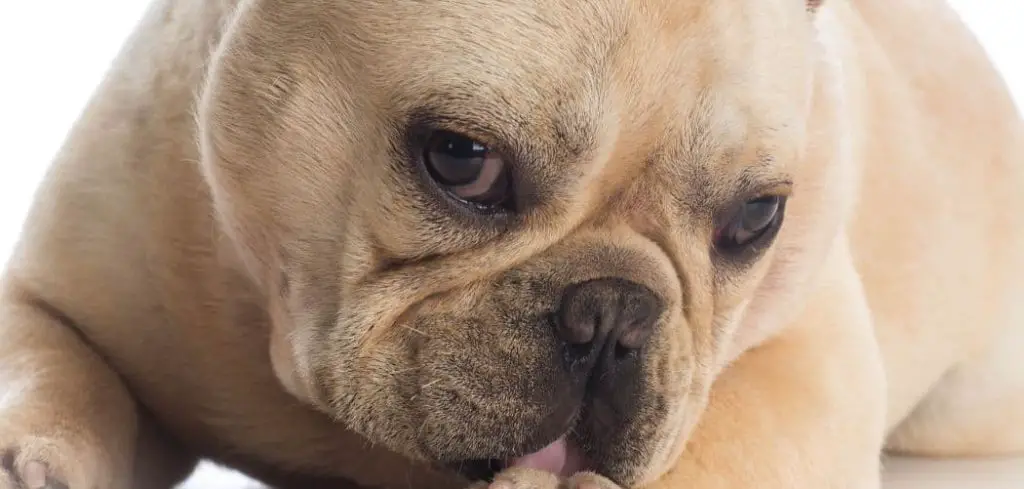Dogs licking their paws occasionally is normal, but when your dog is excessively licking the bottom of their paw, it’s a sign that something is wrong.
Constant licking can cause redness, irritation, and even infection, making it important to identify the root cause quickly.
We outline the common reasons for a dog excessively licking the bottom of their paw, what you can do, and when to seek veterinary help.
Dog Excessively Licking Bottom of Paw — Why It Happens
When a dog excessively licks the bottom of their paw, it’s usually due to discomfort, pain, or irritation. Common triggers include allergies, foreign objects like grass seeds, insect bites, fungal infections, or even anxiety-driven behaviors.
While some causes are minor and easily managed at home, others can worsen without veterinary attention, especially if open sores or swelling develop.

Dog Excessively Licking Bottom of Paw: Common Causes
Allergies
Allergies are one of the most frequent causes of excessive paw licking. Environmental allergens such as pollen, dust, or mold can make the paw pads itchy and inflamed.
Food allergies may also cause persistent itchiness that drives a dog to lick for relief.
Dog owners often notice red, irritated skin between the toes and sometimes a musty odor if yeast overgrowth develops.
Read more: Dog Licking Paws Excessively (What it means and what to do)
Foreign Bodies
A small foreign object stuck in the paw can cause ongoing irritation. Grass seeds are notorious for burrowing into the skin between the toes, making dogs lick obsessively to try to remove them.
Splinters, small stones, or sharp debris can also trigger licking, swelling, and limping. If not removed, these objects may lead to abscesses or infection.
Insect Bites or Stings
Bug bites on the paw pad or between the toes are painful and itchy. A bee sting, ant bite, or spider bite may lead to localized swelling, redness, and compulsive licking.
While many bites resolve on their own, some dogs experience allergic reactions, which can worsen swelling and make licking more intense.
Fungal or Bacterial Infections
Paw pads provide a warm, moist environment that is ideal for infections to develop, especially if a dog licks excessively.
Yeast infections often cause brown staining on the fur and a strong odor, while bacterial infections may cause swelling, pus, or open sores. Left untreated, infections can worsen quickly, making prompt care essential.
Anxiety or Compulsive Behavior
Sometimes paw licking has nothing to do with a physical problem. Dogs that are stressed, bored, or anxious may develop a compulsive licking habit.
This behavior releases soothing endorphins, but over time it damages the paw and creates painful sores.
Identifying and addressing the underlying stress is key to breaking the cycle.
Arthritis or Joint Pain
Older dogs or those with joint issues may lick their paws to soothe pain radiating from the joints.
While the discomfort originates in the leg, the dog may focus on licking the paw pad area. This is often accompanied by stiffness, limping, or reluctance to exercise.
What to Do If Your Dog Is Excessively Licking the Bottom of Their Paw
If your dog is licking the bottom of their paw, first inspect the area carefully. Look for redness, swelling, debris, or signs of an insect bite. If you notice a small irritant like a thorn, gently remove it and clean the paw with mild antiseptic solution.
For mild irritation, soaking the paw in warm water with an antiseptic rinse can provide relief. You can also apply a vet-approved paw balm or protective bootie to reduce further licking. If allergies are suspected, wiping your dog’s paws after walks can help remove environmental triggers like pollen or dust.
For dogs prone to anxiety-related licking, increasing exercise, providing mental enrichment, and using calming aids may reduce the behavior. Distraction with chew toys or puzzle feeders can also help shift the focus away from paw licking.
If the paw looks infected — with discharge, swelling, or a foul odor — it’s best to consult a vet promptly. Avoid using human creams or medications without guidance, as some can be toxic to dogs.
When to Call or Visit Your Vet
You should seek veterinary attention if your dog’s paw licking is persistent and you cannot find a clear cause. Immediate care is especially important if:
The paw is red, swollen, or bleeding
There is pus or a foul odor
Your dog is limping or avoiding putting weight on the paw
Licking is accompanied by fever, lethargy, or loss of appetite
Your dog has a history of severe allergies or skin infections
A vet can examine the paw closely, remove any foreign object, and prescribe medication if infection or inflammation is present.
For allergies, your vet may recommend antihistamines, medicated shampoos, or dietary changes. In cases of anxiety-driven licking, behavioral support and possibly calming medications may be suggested.
Read more: Dog Excessively Licking Back Paws (Here’s why it happens)
Key Takeaway
Excessive licking of the bottom of a paw is usually a sign that your dog is uncomfortable, whether from allergies, infection, injury, or even stress.
While mild cases may improve with simple home care, ongoing or severe licking should never be ignored.
By monitoring your dog closely, providing at-home relief when appropriate, and contacting your vet when needed, you can help your dog stay comfortable and prevent complications.
